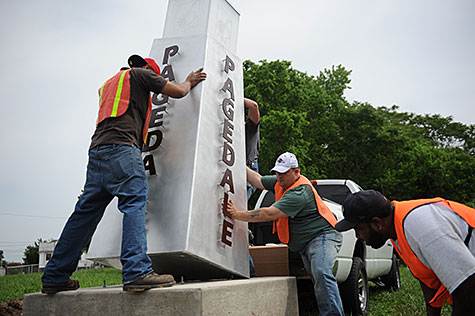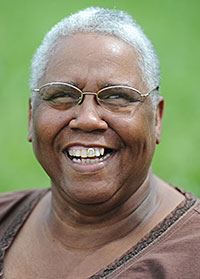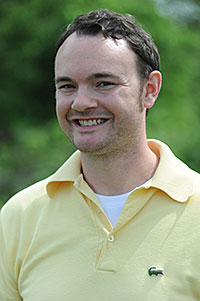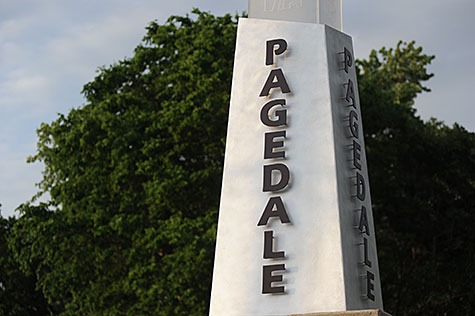
“Hey! Faye!”
It’s a sunny spring morning in the 6600 block of Page Avenue. A passing motorist calls out to Faye Millet, who sits on a short concrete stoop leading to an empty grass lot — the only remnant of some long-demolished residence. She smiles and waves back.

“We’re a small community,” says Millet, 1st ward alderwoman for the City of Pagedale. As if making the point, a teenager in a “Snoopy” T-shirt lopes across the street and takes her arm. “This is my grandson,” she says, smiling.
With just 3,300 residents, Pagedale is a small community, but its history is emblematic of the challenges facing many inner-ring suburbs. Since the 1960s, the city has experienced profound demographic shifts as well as systematic disinvestment and plummeting median income. Its poverty rate in the 2000 census was five times the St. Louis County average.
But in recent years, things have been looking up. Millet points down the street to the Save-A-Lot grocery store, which opened in 2010; to a new senior living center, which opened last fall; and to the Midwest BankCentre — Pagedale’s first full-service bank — which occupies the ground floor.
“I think when you have good leadership, people can communicate with you and feel that things are not going to falter,” Millet says. “If we all work together, there’s nothing that can stop us from growing.”
Where is there a need?
Today, Millet and fellow alderwoman Marla Smith are overseeing the installation of a monumental new welcome sign designed by students from the Sam Fox School of Design & Visual Arts.

Four workmen maneuver the tapered, 11-foot-tall structure — fabricated from aluminum and acrylic and weighing about 250 pounds — onto a low concrete plinth near the city’s eastern border.
“It’s sort of an obelisk concept,” says Albie Mitchell, lecturer in architecture, who led the class. “We considered using cast concrete, but for something this size, it would have been very expensive. And heavy. You’d have needed a crane.”
The project began last fall, when Mitchell and students in the seminar “Reconsidering the Margin: Creative Practice on the Fringe” first met with city officials, and with representatives of Beyond Housing, a non-profit development organization active in the area.
“We didn’t really have a specific project,” Mitchell explains. “So we talked to all of the partners and asked, ‘Where is there a need?’”
A sense of pride
After settling on the idea of signage, the class developed a feasibility plan and explored several sites before selecting a grassy rise at the intersection of Page and Kingsland avenues. Working in teams, the students crafted four proposals and presented them to city officials. Options ranged from a concrete version of the city logo (itself designed by a previous class) to oxidized steel sheets that would pay homage to Pagedale’s industrial roots.
Next, Mayor Mary Carter invited students to present their work at a specially called community meeting. “Attendees voted on the ones they liked,” Mitchell says. “This one emerged as the clear favorite.”
Finally, students produced detailed construction documents, which the city used to bid the job. Troco Custom Fabricators built the piece this spring and installed it at the end of May.
“For the people who live here, it’s about developing a sense of pride,” Mitchell says. “For people from outside the community, it’s about coming to understand Pagedale as its own place with its own history and its own community.”
Designing experiences
The new sign is just one of a half-dozen Pagedale projects that WUSTL students and faculty have completed in recent years. In addition to the city logo, previous initiatives have ranged from a community orchard and a shade pavilion to a rain garden near City Hall and a health impact assessment of Page Avenue redevelopment.
Next fall, Mitchell and “Reconsidering the Margin” will return to Pagedale to create a signage and way-finding campaign. The project comes in conjunction with Pagedale Determined, a new initiative that encompasses both regional planning for sustainable development and a Great Streets Initiative grant to improve sidewalks and lighting.
“One of the nice things about this class is that we can have a real interdisciplinary mix of students,” Mitchell says. “This last project was very tangible, very physical. One of the goals for next semester will be to put even more emphasis on the design process and engaging the community.
“How do you design not just an object, but an experience?”
